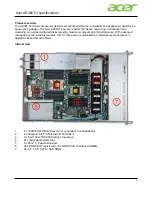
v
There
must
be
at
least
one
memory
card
with
one
pair
of
DIMMs
installed
for
the
server
to
operate.
v
When
you
install
additional
DIMMs
on
a
memory
card,
be
sure
to
install
them
in
pairs.
All
the
DIMM
pairs
on
each
memory
card
must
be
of
the
same
size
and
type.
v
Add
odd-numbered
DIMMs
to
each
available
memory
card
first,
and
then
add
the
even-numbered
pairs.
v
Install
the
DIMMs
on
each
memory
card
in
the
order
shown
in
the
following
table.
Each
memory
card
must
have
at
least
one
pair
of
DIMMs.
See
the
User’s
Guide
on
the
IBM
Documentation
CD
for
additional
memory
configuration
installation
sequences.
Table
2.
Memory
card
installation
sequence
Installation
order
Memory
card
DIMM
pair
First
1
1
and
3
2
and
4
Second
2
1
and
3
2
and
4
Third
3
1
and
3
2
and
4
Fourth
4
1
and
3
2
and
4
v
If
memory
mirroring
is
enabled,
you
can
hot-replace
one
memory
card
at
a
time
on
each
memory
power
bus.
If
a
problem
with
a
DIMM
is
detected,
light
path
diagnostics
will
light
the
system-error
LED
on
the
front
of
the
server,
indicating
that
there
is
a
problem
and
guide
you
to
the
defective
DIMM.
When
this
occurs,
first
identify
the
defective
DIMM;
then,
remove
and
replace
the
DIMM.
The
following
illustration
shows
the
LEDs
on
the
memory
card.
Memory Hot-Swap Enabled
Memory Port Power
Error
Memory
Hot-Swap
Enabled
LED:
When
this
LED
is
lit,
it
indicates
that
hot-swap
memory
is
enabled.
Error
LED:
When
this
LED
is
lit,
it
indicates
that
a
DIMM
or
memory
card
has
failed.
Memory
Port
Power
LED:
When
this
LED
is
off,
it
indicates
that
power
is
removed
from
the
port
and
that
you
can
remove
the
memory
card
to
replace
a
failed
memory
card
or
DIMM.
Installing
a
DIMM
Complete
the
following
steps
to
install
additional
DIMMs:
Chapter
2.
Installing
options
13
















































